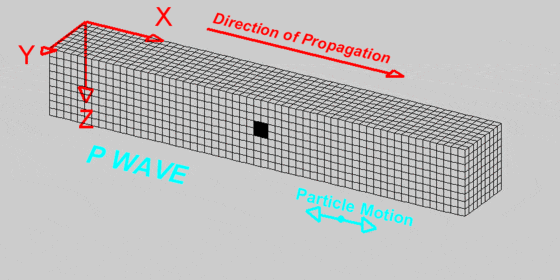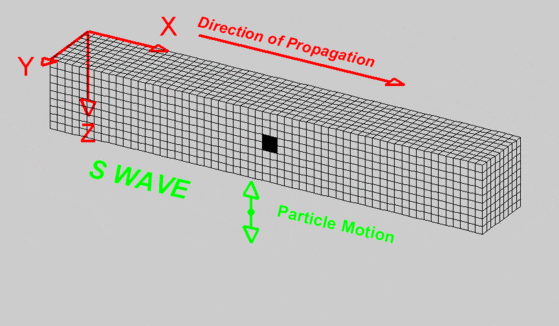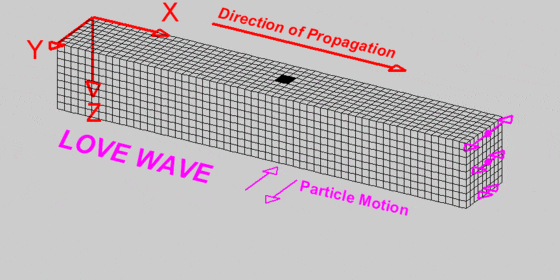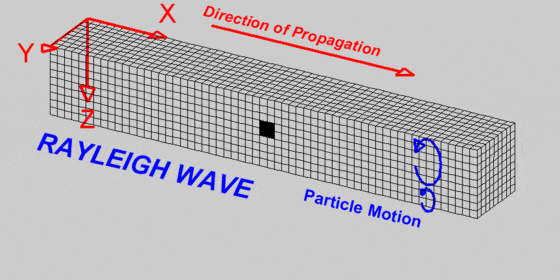Types of Earthquake waves
Articles > Types of Earthquake wavesAuthored by: Akram Jan Jaffar
Earthquake is a natural phenomenon, which causes destruction to buildings, and infrastructure, and death to the lives of human beings, animals, and plants. An earthquake is considered a hazardous incident, but, indeed the hazards are not produced by the earthquake itself. Hazardous are those man-made structures, which can not resist earthquakes. There is rarely an example in history, that earthquake has killed anybody. The killers are those structures, which we have been built for our needs and safety, but they proved to be a cause of our death rather than a protective tool. The earth's crust is cracked into many gigantic plates. These plates are known as the Tectonic Plates. The inner molten magma present inside the lower mantle moves up and down as the rice boils inside a cooker. This movement of the liquid is known as convection. The convection movement may be divergent, convergent, and transverse. Two tectonic plates, in which there is a divergent movement, move apart from each other, while the two tectonic plates, under which there is a convergent movement of magma, override each other. There is another convection movement, which causes a transverse movement to the tectonic plates. In such a case, two tectonic plates move-across horizontally. The boundaries of the transversing plates collide with each other, resulting in energetic stress between the sticking blocks of the plates. In spite of the sticking of the gigantic earthen block, the tectonic movement still continues. Due to the gradual but continuous movement of the plates, make the stress release abruptly. The release of the stress emits powerful seismic waves. These seismic waves are known as earthquakes. This article is about the types of earthquake waves or seismic waves. When an earthquake occurs, it releases four types of seismic waves, i.e. P-waves, S-waves, L-waves, and R-waves. All these four waves are categorized into two main groups; one is the body waves, which include the P-waves, and S-waves, and the other is surface waves, which include the L-waves and the R-waves. So, let's start with an explanation of these waves, which one of these waves is less and which one is more catastrophic.
(1). Body Waves:
As the name implies, the body waves are those earthquake waves, which after their emission, travel through the body of the earth, and propagate deeper. These waves are much faster and sometimes, cross through the whole body of the earth. The body waves are the waves, which explain the inner composition of the earth. Body waves are of two types:
(a). P-waves:
P-waves are also known as the primary waves and compressional waves. These waves are the foremost and the fastest waves, emitted from an epicenter. These waves move the earth particles and its medium to-and-fro. The movement of these waves are compressional and dilateral in nature. The movement of earth particles is parallel to the direction of the propagation of the waves. When an earthquake happens, the first pushing-and-pull movement of the earth is called primary waves. The average velocity of these waves is 9 km/sec, but in case of an earthquake of high magnitude, their velocity may exceed 15 km/sec. These waves have the ability to travel through fluid and solid, which is why these waves can be felt on the other side of the globe. The path of these waves is concave. As these waves only move the infrastructure to-and-fro and do not swing the buildings, therefore they bring the least destruction. The primary waves travel all through the body of earth, even through the outer liquid core and the inner solid core, but still, when these waves travel through the liquid core, they mend their path. Because of the diversion in their path, these waves are not felt from 105-140 degrees from the epicenter. The zone where the earthquake is not felt, is known as the ''Shadow Zone''.

The mechanism of primary waves can be best understood by means of the following animation image. The movement of the compressional waves is toward the direction of propagation of the wave.

Courtesy: https://www.geometrics.com
(b). Secondary Waves:
S-waves or secondary waves are the waves, which emit secondary after the arrival of the primary waves. The traveling speed of the waves is slower as compared to the primary waves. These waves are longitudinal in nature. The movement of the earth is perpendicular to the direction of the propagation of the waves. As the movement of the ground is only in an up and down direction, and propagation of the waves is horizontal, therefore, when these waves travel beneath a building, they push different parts of the building one after the other, resulting in swinging the building. The swinging structure are can not sustain due to their inertia and momentum. The velocity of these waves is lower than that of P-waves. These waves travel through the body of the earth, when they reach the outer liquid core, their propagations comes to an end. The propagation of these waves can be best understood by the following diagram.

The mechanism of the S-waves can be understood by means of the following animation clip. The longitudinal movement of the particles is perpendicular to the propagation direction.

(2). Surface Waves:
As the name implies, these waves do not travel through the deeper layers of the earth. Their propagation is limited to the upper surface. Their amplitude decreases with the depth. These waves are also divided into two types. One is Surface/Love waves and the other is Raliegh Waves. Details and the difference between the two are in the following headings.
(a). Long Waves (L-waves):
The third type of wave is called the L-wave, or Long waves (having longer wavelength). These waves are also known as surface or love waves. As the name implies, these waves only travel through the surface of the earth, and their amplitude decreases with depth. These waves are the most less destructive among the seismic waves. These waves are named after ”Augustus Edward Hough Love” which is why they are known as the Love Waves. Love waves also travel with a lower velocity is compared to body waves. Like the secondary waves, the love waves are also longitudinal in nature and act as the secondary waves while traveling through different states of the medium. The only difference between the secondary waves and the Love waves is, the Love waves travel through the surface, while the secondary waves travel through the body of the earth. Love Waves are created when particles vibrate perpendicular to the propagation direction. While the particle motion is similar to that of shear waves, Love wave amplitude is much higher and decreases rapidly with depth. Love waves are the most destructive waves in earthquakes because of their high amplitude and transverse particle motion.

In the case of love waves, the particles of the ground vibrate perpendicularly to the direction of propagations of the waves, but the movement of the particles is transverse to the direction of the wave-propagation. The complex movement of the particles makes these waves most destructive.
(b). Rayleigh Waves:
Rayleigh waves are another type of surface wave, in which the motion of the particles is elliptical and characterized perpendicular to the direction of the propagation of the wave. These are the least destructive waves. Rayleigh waves are differentiated from the Love-waves on the basis of particle motion. In Rayleigh waves, the particles move up and down (perpendicular to the direction of wave propagation), while in the case of Love-waves, the particles vibrated perpendicular to the direction of propagation of waves, but move transverse to the direction of the propagation of the wave.

In the case of Rayleigh Waves, the motion of the particles is elliptical.
 Read also:
Read also:
- Types of Earthquake waves
- Types of Earthquake waves
- Types of Earthquake waves
- Types of destructions caused by earthquakes
- Load Combinations
 Share:
Share:
Follow our official Facebook page (@civilengineeringbible) and Twitter page (@CivilEngBible) and do not miss the best civil engineering tools and articles!

